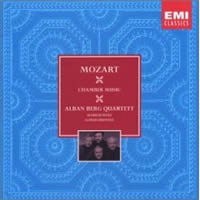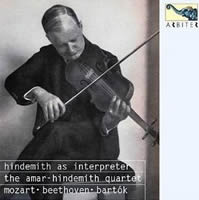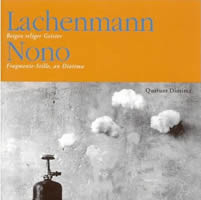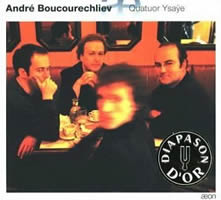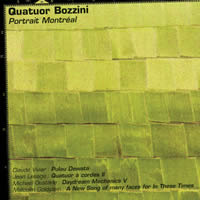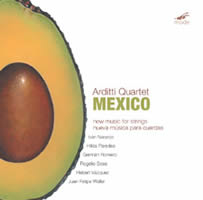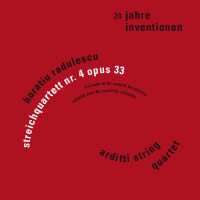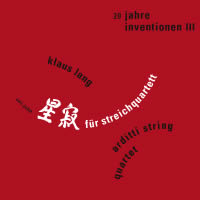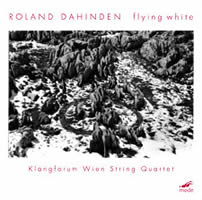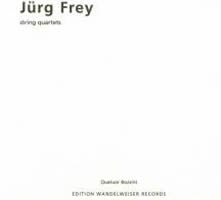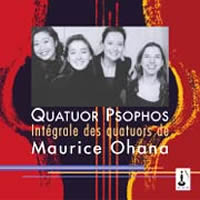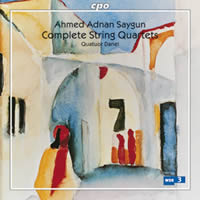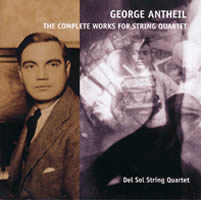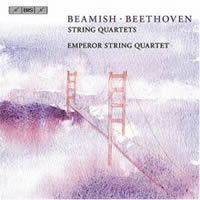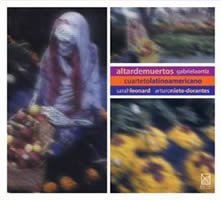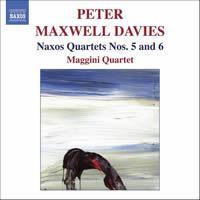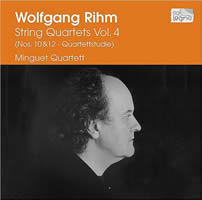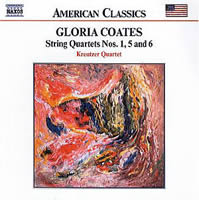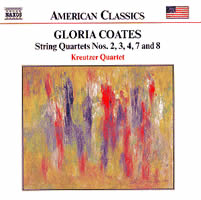Never Enough String Quartets!
|
Grant Chu Covell [December 2006.]
Is it possible to tire of string quartets? Not where I sit! A current favorite is the Alban Berg Quartet’s performance of Mozart’s E-flat Quartet, K. 428, on the seven-disc EMI 7243 5 85581 2 8. For historical perspective, we’ve also been listening to a reissued 1926 recording of the Amar-Hindemith Quartet (Arbiter 139, “Hindemith as Interpreter,” http://www.arbiterrecords.com/), which also includes Beethoven’s Op. 95 and the first-ever recording of Bartók’s Second. The ABQ’s K. 428 pacing is sublime, with perfect intonation in the tricky ascending fifths at the slow movement’s start. Such details are harder to catch with the Amar-Hindemith, whose classics are neat and uncluttered. Less than a decade old when they recorded it, their Bartók will turn heads. Passages played expressively today come across as stern, almost cubist, whereas rigid sections are read lyrically. I wonder when this shift occurred. Among today’s interpretations, the Borromeo, Emerson and Vermeer all offer consistent views. Perhaps modern ensembles might want to have a look at the Amar-Hindemith’s approach.
Helmut LACHENMANN: Streichquartett No. 2, “Reigen seliger Geister” (1989); Luigi NONO: Fragmente-Stille, an Diotima (1979/80). Quatuor Diotima: Eiichi Chijiiwa, Nicholas Miribel (vlns), Franck Chevalier (vla), Pierre Morlet (vlc). M10 Assai 222492. Sadly, M10 / Assai evaporated a couple of years back, so this disc may be hard to trace. André BOUCOURECHLIEV: Quatuor III (1994); Miroir 2 (1989); Archipel II (1968). Quatuor Ysaÿe: Guillaume Sutre, Luc-Marie Aguera (vlns), Miguel da Silva (vla), François Salque (vlc). Aeon AECD 0102 (http://www.aeon.fr/). Distributed in the US by Harmonia Mundi (http://www.harmoniamundi.com/). Lachenmann and Nono make a smart pair. What else would you expect from a quartet that lifts its name from the Italian’s only completed effort in the genre (he was working on another when he died). Reflexively, the Diotima forces a compare with the Arditti (Lachenmann on Auvidis Montaigne MO 782019, Nono on MO 789005) and of course the LaSalle (premiering the Nono on DG 415 513-2). Nono’s Fragmente-Stille, his first chamber music opus, is a strange, unidiomatic quartet the materials of which emerge as if constricted. The sound production techniques are no more advanced than Bartók’s, but the silences, changing textures and absence of graspable signposts suggest a wholly new idiom. The listener detects neither the many Hölderlin quotes nor the buried musical references. Where the premiering LaSalle was fragile and the Arditti assertive, the Diotima rediscovers the quartet’s mystery, their touch more delicate than the Arditti’s, and they’re not as awestruck as the groundbreaking LaSalle. Even trickier to pin down, Lachenmann’s Second buries references to Gluck’s Orpheus and Eurydice under a desolate landscape of still unfamiliar effects, among them an arresting “backwards” sound: a vibratoless note with minimal attack which quickly swells before being stifled to prevent resonance. Sometimes we hear the strings tapped or stroked with the bow’s metal screw. Instruments are mistuned and there’s an extended pizzicato section played with guitar picks. Compared to the premiering dedicatees’ 28:56 single track, the Diotima’s 12 continuous parts span 27:59 and give a more romantic reading but expose many subtleties. The work definitely merits the Arditti’s brutal approach, but the Diotima have made it wholly their own. Beyond mid-century’s European giants Boulez, Stockhausen and Nono, and even such as Berio, Henze and Ligeti, there’s a wild field of obscured talents, to wit, Barraqué, Malec, Globokar and Boucourechliev. The eminent Ysaÿe presents the Bulgarian-born composer-musicologist’s complete quartets, including first recordings of the 12-minute Third and Miroir 2, which was dedicated to them. Boucourechliev’s quartets revere the classic string-quartet literature: The five-movement Miroir 2 reflects deep admiration for Beethoven, and the mobile Archipel II hides the Bartók Sixth’s mesto theme. Influenced by Eco’s “open form” and other compositions which offered performers multiple paths, e.g., Boulez’s Third Piano Sonata, Archipel II, drawn upon two gigantic sheets, prescribes various flows from one page to another, which the players must chart and follow. The valedictory Third reclaims a conventional design the Ysaÿe sensitively sculpts. Webern bits zip past like luminous insects. As with Archipel II’s Bartókian nod, it’s surprising to hear repeated allusions at the periphery. These definitive performances complete our understanding of 20th-century trends, and demonstrate that different paths and voices existed. Seek out Boucourechliev’s electronic works and piano concerto on Thrène (INA C 2025).
“Portrait Montréal.” Claude VIVIER: Pulau Dewata (1977, arr. M. Oesterle, 2002); Jean LESAGE: Quatuor à cordes II (2001); Michael OESTERLE: Daydream Mechanics V (2001); Malcolm GOLDSTEIN: A New Song of many faces for In These Times (2002). Quatuor Bozzini: Clemens Merkel, Nadia Francavilla (vlns), Stéphanie Bozzini (vla), Isabelle Bozzini (vlc). CQB 0401 (http://www.quatuorbozzini.ca/). Distributed in the US by Forced Exposure (http://www.forcedexposure.com/). “Arditti Quartet: Mexico – New Music for Strings.” Juan Felipe WALLER: De jaque, sal, gala y luna (1999); Hebert VÁZQUEZ: String Quartet No. 1 (1999); Germán ROMERO: Ramas (2002); Iván NARANJO: Uno (2002); Rogelio SOSA: Espasmo fulgor (2002); Hilda PAREDES: Uy u’tan (1998). The Arditti Quartet: Irvine Arditti, Graeme Jennings (vlns), Dov Scheindlin (vla), Rohan de Saram (vlc). mode 165 (http://www.moderecords.com/). The Bozzini’s wonderful debut self-release explores four diverse Canadians (CQB 0502 followed with Reich’s Different Trains). Vivier ought to be the most familiar. A Stockhausen student and Grisey follower, his murder is deplored by many as a blow to music. Originally scored for percussion, the quirky Pulau Dewata, “infused with the spirit of Bali,” reflects Vivier’s voracious response to influences. Winking at Satie, Lesage’s Second in six short movements flirts with expectations and forms. In delicately muted tones, Oesterle’s magical Daydream Mechanics V sequences stanzas the delicate harmonies of which support a gently ornamented perpetual motion. Hushed speech signifies each stanza’s change. Keep an eye out for CQB’s upcoming new Oesterle release. Goldstein asks for structured improvisation and receives a hearty compendium of smartly used avant-garde techniques in return. Montréal is well worth the trip. Elsewhere in North America, the Arditti is in top form, as are its leader’s solos. Sosa’s Espasmo fulgor for Paganini-drenched violin and lithe electronics demands replay. Amazingly, all its electronic sounds derive from the violin. Another solo, Waller’s De jaque, sal, gala y luna, alternates rhapsodic passages with sul ponticello musings and aggressive motifs. Romero’s Ramas amplifies Arditti’s violin, exuding coarse meditation. In Vázquez’s dynamic “Exposición” and “Relectura” paired players must argue amongst themselves as in Ives’ Second, though the biting language echoes Carter and Xenakis. Naranjo’s Uno broadly expounds a vast field with unexpected pacing and juxtapositions. Paredes’ Uy u’tan (“listen how they talk” in Mayan) also explores multiple personalities. Listeners expecting the Ardittis to go native as did the Kronos with Golijov’s help on “Nuevo” (Nonesuch 79649-2) will be disappointed. You’ll hear nothing overtly pop or ethnic, and Revueltas and Esquivel are miles away, yet it would be wrong to characterize these composers as European wannabes. Here’s another neighboring country to explore.
“20 Jahre Inventionen, Vol. 1.” Horatiu RADULESCU: Streichquartett Nr. 4, Op. 33 (1976-87). Arditti String Quartet: Irvine Arditti, Graeme Jennings (vlns), Garth Knox (vla), Rohan de Saram (vlc). Edition RZ 4002 (http://www.edition-rz.de/). Distributed in the US by Forced Exposure (http://www.forcedexposure.com/). “20 Jahre Inventionen, Vol. 3.” Klaus LANG: Sei-Jaku (2001). Arditti String Quartet: Irvine Arditti, Graeme Jennings (vlns), Dov Scheindlin (vla), Rohan de Saram (vlc). Edition RZ 4005 (http://www.edition-rz.de/). Distributed in the US by Forced Exposure (http://www.forcedexposure.com/). Burdened with the cumbersome subtitle “infinite to be cannot be infinite, infinite anti-be could be infinite” (presumably related to a line from Hamlet), Radulescu’s Fourth is scored for quartet and tape which represents an “imaginary 128-stringed viola da gamba” or eight string quartets with open strings tuned to spectra derived from a low 1Hz C and residing between the 36th and 641st harmonics. As the colossal gamba churns and whirls, the live quartet works through 89 sections of specified lengths, playing material generated from a gradually climbing fundamental. It’s dizzying and claustrophobic, but as to expected from Radulescu, tautly organized. Lang’s Sei-Jaku (“tarnished star” in Japanese, though the characters also represent a concept in Japanese aesthetics) visits the land of closely-miked scritches and scratches wherein turned pages evoke earthquakes. With Lachenmann hovering in the wings, this 40-minute quartet sifts subtle plinks, slowly drawn bow-strokes and slight pizzicatos. There’s little forward motion. Varied sounds and silences emerge like rain on a beach, leaving soon-to-be-obliterated marks. Some will argue that only the Arditti can take this stuff seriously, and that’s probably true — it’s hard to ignore that the program note’s first half enthusiastically discusses sashimi — but there is ample room in the world for such explorations. Only time will tell whether Radulescu and Lang are milestones or detours.
“flying white.” Roland DAHINDEN: String Quartet No. 2, “mind rock” (2000); String Quartet No. 3, “mond see” (2001); String Quartet No. 4, “flying white” (2003); String Quartet No. 5, “poids de l’ombre” (2004). Klangforum Wien String Quartet: Annette Bik, Sophie Schaffleitner (vlns), Dimitrios Polisoidis (vla), Andreas Lindenbaum (vlc). mode 175 (http://www.moderecords.com/). Jürg FREY: Streichquartett (1988); (Unbetitelt) VI (1990/91); Zwei allerletzte Sächelchen (1990); Streichquartett II (1998-2000). Quatuor Bozzini: Clemens Merkel, Nadia Francavilla (vlns), Stéphanie Bozzini (vla), Isabelle Bozzini (vlc). Edition Wandelweiser EWR 0410 (http://www.timescraper.de/_e-w-records/_ewr-catalogue/index.html). Available in the US at CDeMUSIC (http://www.cdemusic.org/). Within an unhurried — some would suggest naïve — style, Dahinden plumbs variety. Chords and tones, often muted, sul ponticello or with hushed expectancy, change at a meandering pace. Dahinden, drawing inspiration from the visual arts, dedicates these works to Richard Long, Inge Dick, Brice Marden and Stéphane Brunner. (Long provided the spark for Dahinden’s piano quintet). I sense different emtional qualities: The Third is the most hesitant, the Fourth slightly depressed, and the Fifth (the longest) calmest. While Feldman made such music possible, we hear no discernable gestures undergoing gentle variation. The impeccable Klangforum Wien plays as one, befitting these broadly monochromatic pieces. I don’t think a plucked note appears anywhere. Two quartets (Third and Fourth) are binaural recordings that via headphones have sounds swirling delicately around the listener. Frey’s First, while likewise partaking of a Feldmanesque aura, realizes something more static and compact. Even on repeated hearings the Swiss composer’s work ends abruptly. VI contains long solo passages of uneven scales, reminding one of skyward ladders. Its few chordal moments startle. The two allerletzte Sächelchen are sub-minute phrases. Frey’s hushed Second will take your breath away, notwithstanding a resemblance to one’s final earthly moments. EWR captures a delicate sonority, sounding like quiet humming, muted bowing and hushed sul ponticello tremolando. This otherworldly quartet conjures the a cappella passages of Verdi’s Requiem.
“Intégrale des quatuors de Maurice Ohana.” Maurice OHANA: Quatuor No. 1 (1963); Quatuor No. 2 (1980); Quatuor No. 3 (1989). Quatuor Psophos: Ayako Tanaka, Bleuenn Le Maître (vlns), Cécile Grassi (vla), Ingrid Schoenlaub (vlc). Ar Ré-Sé 2004-7 (http://www.lydiajardon.com/arrese1_en.html). Distributed in the US by Forte Distribution (http://www.fortedistribution.com/). Ahmed Adnan SAYGUN: String Quartet No. 1, Op. 27 (1947); String Quartet No. 2, Op. 35 (1958); String Quartet No. 3, Op. 43 (1966); String Quartet No. 4, Op. 77 (1990, incompl.). Quatuor Danel: Marc Danel, Gilles Millet (vln), Tony Nys (vla), Guy Danel (vlc). cpo 999 923-2 (http://www.cpo.de/). Distributed in the US by Naxos (http://www.naxos.com/). Ohana’s quartets are perhaps his most immediate compositions. Hearing a consistently assured hand, I was surprised to learn that more than a quarter-century separates the First from the Third. To characterize Ohana’s hybrid of North African and Mediterranean colors as odd oversimplifies. (Born in Casablanca, he retained his British citizenship while settling in France.) To this traditional ensemble he brings unexpected forms and scales by way of third and fifth tones. A close cousin to Dutilleux, the composer’s indebtedness to Messiaen’s Turangalîla is obvious. The Psophos demonstrates jubilant rigor. Unison passages which could easily frustrate weaker ensembles are spellbinding here as the team offers matched vibrato and concentrated expression. Saygun’s four employ unfamiliar modes and uncommon meters — comparisons with Bartók are inevitable — but the series stagnates as the decades pass. The First begins with a mysterious unison opening. Later the Danel render its gently ethnic Adagio lovingly. The Second’s fugal opening huddles close to Ludwig and Béla. Its slow movement is an inventive set of atmospheric variations, followed by a taut and punchy scherzo. Despite their completion dates, the last two quartets (the unfinished Fourth exists as two fragmentary movements) share the earlier pair’s mien. The Third’s opening Grave hides two unexpected moments before the recapitulation: a minimalist thematic replay and a stunning all-glissando passage, unexpected in a work that echoes Bartók’s idiom. I’m eager to hear anything the Danel attempts. Their Goeyvaerts (Megadisc 7853), De Clerck (Megadisc 7866) and Lampson (col legno WWE 1CD 20243) are wonderful.
“The Complete Works for String Quartet.” George ANTHEIL: Lithuanian Night (1922); Quartet No. 1 for Strings (1925); Quartet No. 2 for Strings (orig. ver. 1927); Six Little Pieces for String Quartet (1931); Quartet No. 3 for Strings (1948). Del Sol String Quartet: Kate Stenberg, Rick Shinozaki (vlns), Charlton Lee (vla), Monica Stott (vlc). Other Minds OM 1008-2 (http://www.otherminds.org/). Distributed in the US by Allegro Music (http://www.allegro-music.com/). “Complete String Quartets.” Joseph MARX: Quartetto in modo antico (1937-38); Quartetto in modo classico (1940-41); Quartetto chromatico (1936, rev. 1948). Thomas Christian Ensemble: Thomas Christian, Melina Mandozzi (vlns), Ferdinand Erblich (vla), Bernhard Naoki Hedenborg (vlc). cpo 777 066-2 (http://www.cpo.de/). Distributed in the US by Naxos (http://www.naxos.com/). “Bad Boy” Antheil’s snide juxtapositions have not worn well. What may have been refreshingly outré in the 1920s now sounds flippant. However, this doesn’t quite negate the cheekiness of Antheil’s having ladeled out overcooked Stravinsky alongside mashed jazz and Cole Porter. What must have been intended as furniture-music passages suffocate the surrounding pages. There are no airplane propellers to hide behind. The Third’s start sends Dvorak out West and ends with a Shostakovichian rondo — surprising since DSCH was just warming up to quartets. Two items, the original version of the Second and Six Little Pieces for String Quartet (1931), receive first recordings. The Del Sol acquit their task neutrally; more abandon might have thrown these pieces into sharper relief. Marx’s antico, classico and chromatico designations suggest Respighian dabbling, but he is far more sincere and studious. (He stuck it out in Austria during WWII and adopted older styles as a means of distancing himself from current events.) An admirer of Reger and friend to Ravel, the Austrian was able to join rigorous forms to charming colors. He was tonality’s standard bearer during trying times, his well-wrought Romantic blends now largely forgotten. Due any day is a recording of Marx’s acclaimed 1921 Herbstsymphonie. Antico’s four movements hold squarely to church modes. Classico refers to Haydn. Where Prokofiev’s adoption of the moniker lead to sarcasm under spiked heels, Marx unrolls a velvet carpet through candy-striped canopies. The chromatico is a tipsy Berg in Paris. Marx’s plushy textures nicely mask the Thomas Christian Ensemble’s occasionally thin violins.
Sally BEAMISH: String Quartet No. 1 (1999); String Quartet No. 2, “Opus California” (2000). Ludwig van BEETHOVEN: String Quartet in C-Minor, Op. 18, No. 4 (1798-1800). Emperor String Quartet: Martin Burgess, Clare Hayes (vlns), Fiona Bonds (vla), William Schofield (vlc). BIS CD 1511 (http://www.bis.se/). Distributed in the US by Qualiton (http://www.qualiton.com/). Gabriela ORTÍZ: Baalkah (2000); Altar de muertos (1996); Seis piezas a Violeta (2002). Cuarteto Latinoamericano: Saúl Bitrán, Arón Bitrán (vlns), Javier Montiel (vla), Álvaro Bitrán (vlc); Sarah Leonard (sop), Arturo Nieto-Dorantes (pno). Urtext Digital Classics JBCC 108 (http://www.urtextonline.com/). Distributed in the US by Allegro Music (http://www.allegro-music.com/). Going head-to-head with Beethoven, Beamish sets herself up for quite a challenge. With respect to her First, I’ll take Beethoven, but her clever Second, “Opus California,” survives the comparison. This 10:48 quartet’s four movements gently riff on motifs from Op. 18, No. 4’s first movement. Where the First was moody, even conventionally contemporary, the Second is more wistful, with some jazz and mid-century pop touches. Those not attuned to the piece’s M.O. might miss the Beethoven allusions. The onetime Raphael Ensemble violist’s compositions are set in a good light, and we can appreciate the Emperor’s clean and competent playing. With its eerie knocking and ankle-worn rattles, Ortíz’s Altar de muertos celebrates the Day of the Dead. The movement’s moods are distinct, and when Ortíz develops her materials, Bartók hints emerge (II around 2:50). The finale’s bright coda with Nyman-like motion makes a surprising ending. The Seis piezas a Violeta for piano quintet collect small pieces whose modalities sometimes hint at Messiaen. Leonard, best known for her involvement with Lachenmann, et al., joins the Cuarteto Latinoamericano for the five-part Baalkah (Mayan for “world” or “cosmos”). Here she sounds unusually nasal, as if the recording took place under less than ideal circumstances. Neither the quintet nor the songs possess the quartet’s energy and grit.
Peter MAXWELL DAVIES: Naxos Quartet No. 5, “Lighthouses of Orkney and Shetland” (2004); Naxos Quartet No. 6 (2004-5). Maggini Quartet: Laurence Jackson, David Angel (vlns), Martin Outram (vla), Michal Kaznowski (vlc). Naxos 8.557398 (http://www.naxos.com/). “String Quartets Vol. 4.” Wolfgang RIHM: String Quartet No. 10 (1993/97); String Quartet No. 12 (2000/01); Quartettstudie (2003/04). Minguet Quartett: Ulrich Isfort, Annette Reisinger (vlns), Irene Schwalb (vla), Matthias Diener (vlc). col legno WWE 1CD 20227 (http://www.col-legno.com/). Distributed in the US by Qualiton (http://www.qualiton.com/). Try as I might — and I have tried — I see no value in Maxwell Davies’ lauded quartet series (1 & 2: Naxos 8.557396, 3 & 4: Naxos 8.557397). It’s not the Maggini’s fault, nor do I object to lighthouse celebrations. A new disc with John Ireland’s student quartets (Naxos 8.557777) demonstrates the Maggini’s delicate agility across two Victorian-tinted Brahmsian efforts and a piano arrangement. I’ve no quarrel with Naxos’ ambitions and applaud their commissioning initiative. Nevertheless I’ll remain a naysayer in a wide swath of praise. These tedious quartets are an unfortunate waste of effort and time. I’ve had trouble enjoying Rihm’s recent music. Actually, it’s someplace in the ’90s that this leading German composer lost my interest. In its series, the Minguet offers superbly crafted readings, thrust into high relief under col legno’s superb production values. With bushels of avant garde hijinks and sudden contrasts, the quartets are definitely à la mode. Some gestures, contributing little to the musical argument, are merely in vogue. The Tenth’s middle juxtaposes interesting but ephemeral material. When Ives does this, the result transports, whereas Rihm abandons his overstuffed luggage in the waiting room. This volume does not include the unfinished Eleventh. You won’t hear me complaining.
Gloria COATES: String Quartet No. 1 (1966); String Quartet No. 5 (1988); String Quartet No. 6 (1999). Kreutzer Quartet: Peter Sheppard Skaerved, Gordon MacKay (vlns), Bridget Carey (vla), Neil Heyde (vlc). Naxos 8.559091 (http://www.naxos.com/). Gloria COATES: String Quartet No. 2 (1972); String Quartet No. 3 (1975); String Quartet No. 4 (1976); Quartet No. 7, “Angels” (2000); String Quartet No. 8 (2001-02). Kreutzer Quartet, Philip Adams (org), Michael Finnissy (cond.). Naxos 8.559152 (http://www.naxos.com/). So far numbering eight, Coates’ string quartets are among the most distinctive around. To some they will sound like air-raid sirens at music’s unseemly fringe. Nancarrow and Ligeti fans should enjoy the canonic designs, Scelsi aficionados will marvel at the continuous glissandos and microtones, and Pärt and Ives admirers will enjoy the reflective pacing and hymn-like tunes. The Kreutzer plays with commitment and consistency, taking these eerie, transporting works absolutely seriously. Metier’s producer David Lefeber engineered the crack recordings. Multi-octave glissandos in contrary motion may not seem a resourceful way to express ideas, but Coates’ slowly moving structures over tonic underpinnings can equally express sorrow (Eighth, a 9/11 memorial) or Christmastime’s joy (Seventh, with organ). Coates’ First, a 5:43 effort subtitled “Protestation Quartet,” may seem derivative, weaving Bartók among subtle canons, as tendencies more abstracted in the Third and Fourth. From the Fifth onwards, glissandos predominate. Would that Naxos had tossed its commission at Coates!
Antheil, Bartók, Beamish, Beethoven, Boucourechliev, Coates, Dahinden, Frey, Goldstein, K Lang, Lachenmann, Lesage, Marx, Maxwell Davies, Mozart, Naranjo, Nono, Oesterle, Ohana, Ortiz, Parades, Radulescu, Rihm, Romero, Saygun, Sosa, Vazquez, Vivier, Waller
[More Grant Chu Covell, String Quartets]
[More
Antheil, Bartók, Beamish, Beethoven, Boucourechliev, Coates, Dahinden, Frey, Goldstein, K Lang, Lachenmann, Lesage, Marx, Maxwell Davies, Mozart, Naranjo, Nono, Oesterle, Ohana, Ortiz, Parades, Radulescu, Rihm, Romero, Saygun, Sosa, Vazquez, Vivier, Waller]
[Previous Article:
An Infidel’s Glimpse of Paradise: Wilson Audio’s WATT/ Puppy 8]
[Next Article:
New and Essential Xenakis, Part 2]
|
